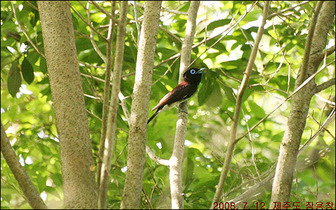Japanese Paradise-Flycatcher
The Japanese Paradise-flycatcher is mainly migratory and breeds in shady mature deciduous or evergreen broadleaf forest of Japan , South Korea, Taiwan and the far north Philippines. It is a non-breeding visitor to mainland China, Hong Kong, Thailand, Laos, Vietnam, Philippines, Malaysia, Singapore, and Sumatra, Indonesia.

The Japanese Paradise-Flycatcher is classified as Near Threatened (NT), is close to qualifying for or is likely to qualify for a threatened category in the near future.
The Japanese Paradise-flycatcher is mainly migratory and breeds in shady mature deciduous or evergreen broadleaf forest of Japan (southern Honshū, Shikoku, Kyushu and the Nansei Shoto islands), South Korea, Taiwan (including Lanyu island) and the far north Philippines. It is a non-breeding visitor to mainland China, Hong Kong, Thailand, Laos, Vietnam, Philippines, Malaysia, Singapore, and Sumatra, Indonesia. More
species, for example the call of the Japanese Paradise-flycatcher is a repeated three syllable whistle. The songs of the African species are more complex and, in the case of species with a large range, vary geographically. The calls are generally simple and are harsh and grating. Behaviour - Diet and feeding The paradise-flycatchers are, as their name suggests, insectivores, feeding on a variety of insects, usually obtained on the wing. More
Japanese Paradise-flycatcher Terpsiphone atrocaudata - Male in breeding plumage Japanese Paradise-flycatcher Photographer : More
The Japanese Paradise-flycatcher is similar in appearance to the Asian Paradise Flycatcher but slightly smaller. Mature males have a black hood with a purplish-blue gloss which shades into blackish-grey on the chest. The underparts are off-white to white. The mantle, back, wings and rump are plain dark chestnut. The tail has extremely long black central feathers, which are shorter in immature males. Unlike the Asian Paradise Flycatcher there is no white morph. More
Found a male Japanese Paradise-Flycatcher: in breeding plumage, this is one of the most glorious Hong Kong birds, with tail well exceeding (twice?) its body length. Also, a globally near-threatened species. At top of Fa Peng valley, a male Blue-and-White Flycatcher, in same tree as saw two of these birds on 7th. Lower in the vally, heard a Pale-legged Leaf-Warbler, and saw small party of at least three Hair-crested Drongos. More
Family : Monarchidae
Genus : Terpsiphone
Species : atrocaudata
Authority : (Eyton, 1839)

